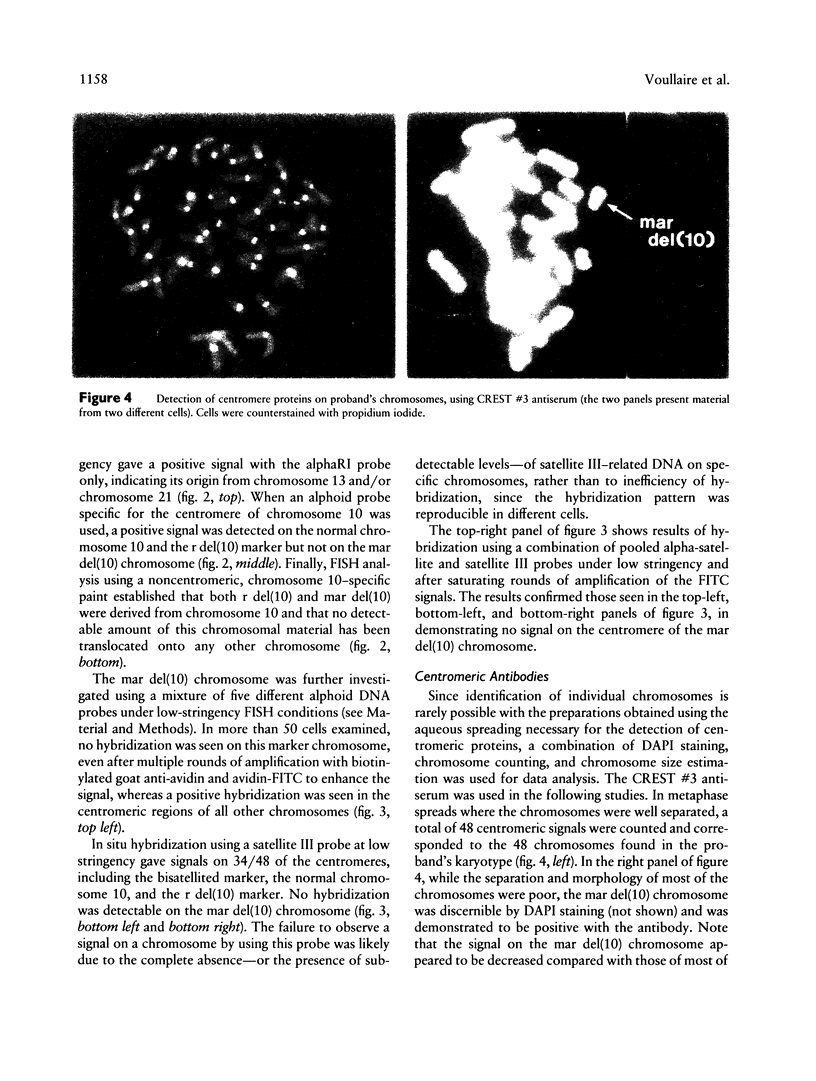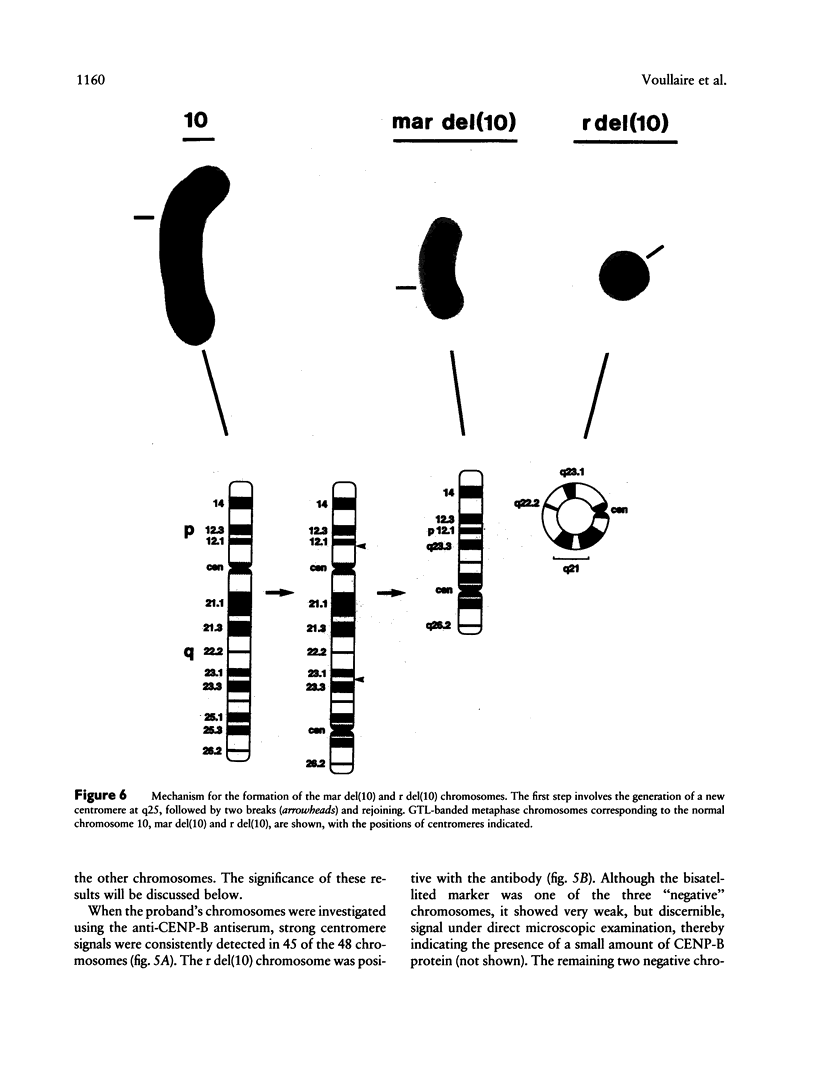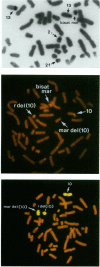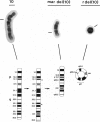Abstract
We report the investigation of an unusual human supernumerary marker chromosome 10 designated "mar del(10)." This marker is present together with two other marker chromosomes in the karyotype of a boy with mild developmental delay. It has a functional centromere at a primary constriction and is mitotically stable. Fluorescence in situ hybridization (FISH) using alpha-satellite and satellite III DNA as probes failed to detect any signal at the primary constriction site. CENP-B protein could not be demonstrated, although the presence of at least some centromeric proteins was confirmed using a CREST antiserum. Consideration of these and other cytogenetic and FISH results supports a mechanism of formation of the mar del(10) chromosome involving the activation of a latent intercalary centromere at 10q25.
Full text
PDF










Images in this article
Selected References
These references are in PubMed. This may not be the complete list of references from this article.
- Aleixandre C., Miller D. A., Mitchell A. R., Warburton D. A., Gersen S. L., Disteche C., Miller O. J. p82H identifies sequences at every human centromere. Hum Genet. 1987 Sep;77(1):46–50. doi: 10.1007/BF00284712. [DOI] [PubMed] [Google Scholar]
- Choo K. H., Brown R., Webb G., Craig I. W., Filby R. G. Genomic organization of human centromeric alpha satellite DNA: characterization of a chromosome 17 alpha satellite sequence. DNA. 1987 Aug;6(4):297–305. doi: 10.1089/dna.1987.6.297. [DOI] [PubMed] [Google Scholar]
- Choo K. H., Earle E., McQuillan C. A homologous subfamily of satellite III DNA on human chromosomes 14 and 22. Nucleic Acids Res. 1990 Oct 11;18(19):5641–5648. doi: 10.1093/nar/18.19.5641. [DOI] [PMC free article] [PubMed] [Google Scholar]
- Choo K. H., Earle E., Vissel B., Filby R. G. Identification of two distinct subfamilies of alpha satellite DNA that are highly specific for human chromosome 15. Genomics. 1990 Jun;7(2):143–151. doi: 10.1016/0888-7543(90)90534-2. [DOI] [PubMed] [Google Scholar]
- Choo K. H., Earle E., Vissel B., Kalitsis P. A chromosome 14-specific human satellite III DNA subfamily that shows variable presence on different chromosomes 14. Am J Hum Genet. 1992 Apr;50(4):706–716. [PMC free article] [PubMed] [Google Scholar]
- Choo K. H., Vissel B., Nagy A., Earle E., Kalitsis P. A survey of the genomic distribution of alpha satellite DNA on all the human chromosomes, and derivation of a new consensus sequence. Nucleic Acids Res. 1991 Mar 25;19(6):1179–1182. doi: 10.1093/nar/19.6.1179. [DOI] [PMC free article] [PubMed] [Google Scholar]
- Cooper K. F., Tyler-Smith C. The putative centromere-forming sequence lambda CM8 is a single copy sequence and is not a component of most human centromeres. Hum Mol Genet. 1992 Dec;1(9):753–754. doi: 10.1093/hmg/1.9.753. [DOI] [PubMed] [Google Scholar]
- Crolla J. A., Dennis N. R., Jacobs P. A. A non-isotopic in situ hybridisation study of the chromosomal origin of 15 supernumerary marker chromosomes in man. J Med Genet. 1992 Oct;29(10):699–703. doi: 10.1136/jmg.29.10.699. [DOI] [PMC free article] [PubMed] [Google Scholar]
- Dewald G. W., Boros S. J., Conroy M. M., Dahl R. J., Spurbeck J. L., Vitek H. A. A tdic(5;15)(p31;p11) chromosome showing variation for constriction in the centromeric regions in a patient with the cri du chat syndrome. Cytogenet Cell Genet. 1979;24(1):15–26. doi: 10.1159/000131352. [DOI] [PubMed] [Google Scholar]
- Dutrillaux B. Chromosomal evolution in primates: tentative phylogeny from Microcebus murinus (Prosimian) to man. Hum Genet. 1979 May 10;48(3):251–314. doi: 10.1007/BF00272830. [DOI] [PubMed] [Google Scholar]
- Grady D. L., Ratliff R. L., Robinson D. L., McCanlies E. C., Meyne J., Moyzis R. K. Highly conserved repetitive DNA sequences are present at human centromeres. Proc Natl Acad Sci U S A. 1992 Mar 1;89(5):1695–1699. doi: 10.1073/pnas.89.5.1695. [DOI] [PMC free article] [PubMed] [Google Scholar]
- Haaf T., Warburton P. E., Willard H. F. Integration of human alpha-satellite DNA into simian chromosomes: centromere protein binding and disruption of normal chromosome segregation. Cell. 1992 Aug 21;70(4):681–696. doi: 10.1016/0092-8674(92)90436-g. [DOI] [PubMed] [Google Scholar]
- Hadlaczky G., Praznovszky T., Cserpán I., Keresö J., Péterfy M., Kelemen I., Atalay E., Szeles A., Szelei J., Tubak V. Centromere formation in mouse cells cotransformed with human DNA and a dominant marker gene. Proc Natl Acad Sci U S A. 1991 Sep 15;88(18):8106–8110. doi: 10.1073/pnas.88.18.8106. [DOI] [PMC free article] [PubMed] [Google Scholar]
- Jørgensen A. L., Bostock C. J., Bak A. L. Homologous subfamilies of human alphoid repetitive DNA on different nucleolus organizing chromosomes. Proc Natl Acad Sci U S A. 1987 Feb;84(4):1075–1079. doi: 10.1073/pnas.84.4.1075. [DOI] [PMC free article] [PubMed] [Google Scholar]
- Jørgensen A. L., Kølvraa S., Jones C., Bak A. L. A subfamily of alphoid repetitive DNA shared by the NOR-bearing human chromosomes 14 and 22. Genomics. 1988 Aug;3(2):100–109. doi: 10.1016/0888-7543(88)90139-5. [DOI] [PubMed] [Google Scholar]
- Lau Y. F., Ying K. L., Donnell G. N. Identification of a case of Y:18 translocation using a Y-specific repetitive DNA probe. Hum Genet. 1985;69(2):102–105. doi: 10.1007/BF00293276. [DOI] [PubMed] [Google Scholar]
- Manuelidis L. Chromosomal localization of complex and simple repeated human DNAs. Chromosoma. 1978 Mar 22;66(1):23–32. doi: 10.1007/BF00285813. [DOI] [PubMed] [Google Scholar]
- Masumoto H., Masukata H., Muro Y., Nozaki N., Okazaki T. A human centromere antigen (CENP-B) interacts with a short specific sequence in alphoid DNA, a human centromeric satellite. J Cell Biol. 1989 Nov;109(5):1963–1973. doi: 10.1083/jcb.109.5.1963. [DOI] [PMC free article] [PubMed] [Google Scholar]
- McGill N. I., Fantes J., Cooke H. Lambda CM8, a human sequence with putative centromeric function, does not map to the centromere but is present in one to two copies at 9qter. Hum Mol Genet. 1992 Dec;1(9):749–751. doi: 10.1093/hmg/1.9.749. [DOI] [PubMed] [Google Scholar]
- Mitchell A. R., Gosden J. R., Miller D. A. A cloned sequence, p82H, of the alphoid repeated DNA family found at the centromeres of all human chromosomes. Chromosoma. 1985;92(5):369–377. doi: 10.1007/BF00327469. [DOI] [PubMed] [Google Scholar]
- Pinkel D., Straume T., Gray J. W. Cytogenetic analysis using quantitative, high-sensitivity, fluorescence hybridization. Proc Natl Acad Sci U S A. 1986 May;83(9):2934–2938. doi: 10.1073/pnas.83.9.2934. [DOI] [PMC free article] [PubMed] [Google Scholar]
- Pluta A. F., Cooke C. A., Earnshaw W. C. Structure of the human centromere at metaphase. Trends Biochem Sci. 1990 May;15(5):181–185. doi: 10.1016/0968-0004(90)90158-8. [DOI] [PubMed] [Google Scholar]
- Pluta A. F., Saitoh N., Goldberg I., Earnshaw W. C. Identification of a subdomain of CENP-B that is necessary and sufficient for localization to the human centromere. J Cell Biol. 1992 Mar;116(5):1081–1093. doi: 10.1083/jcb.116.5.1081. [DOI] [PMC free article] [PubMed] [Google Scholar]
- Prosser J., Frommer M., Paul C., Vincent P. C. Sequence relationships of three human satellite DNAs. J Mol Biol. 1986 Jan 20;187(2):145–155. doi: 10.1016/0022-2836(86)90224-x. [DOI] [PubMed] [Google Scholar]
- Rauch A., Pfeiffer R. A., Trautmann U., Liehr T., Rott H. D., Ulmer R. A study of ten small supernumerary (marker) chromosomes identified by fluorescence in situ hybridization (FISH). Clin Genet. 1992 Aug;42(2):84–90. doi: 10.1111/j.1399-0004.1992.tb03145.x. [DOI] [PubMed] [Google Scholar]
- Wolfe J., Darling S. M., Erickson R. P., Craig I. W., Buckle V. J., Rigby P. W., Willard H. F., Goodfellow P. N. Isolation and characterization of an alphoid centromeric repeat family from the human Y chromosome. J Mol Biol. 1985 Apr 20;182(4):477–485. doi: 10.1016/0022-2836(85)90234-7. [DOI] [PubMed] [Google Scholar]
- Yunis J. J., Prakash O. The origin of man: a chromosomal pictorial legacy. Science. 1982 Mar 19;215(4539):1525–1530. doi: 10.1126/science.7063861. [DOI] [PubMed] [Google Scholar]








